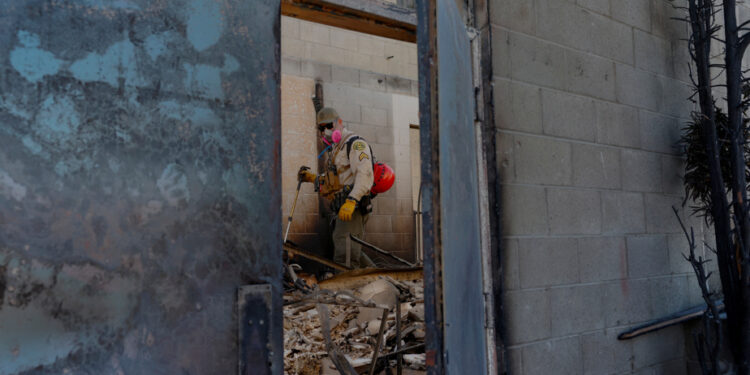(Los Angeles) The megalopolis of Los Angeles is still grappling with flames on Sunday, the fires continuing to gain ground, while even more violent winds are forecast for Tuesday.
Besieged by flames since Tuesday, the second most populous city in the United States continues to count its dead: the toll rose to 16 deaths on Saturday evening and could still evolve, authorities have warned.
“The situation is still critical,” warned Deanne Criswell of the federal natural disaster response agency (FEMA) on ABC on Sunday, calling on the population to remain extremely vigilant.
After a short lull, hot and dry winds are expected to regain strength until Wednesday, complicating the work of firefighters, authorities have warned.
The US Weather Service is forecasting “extreme fire behavior and life-threatening conditions”, which will peak with winds of 110 km/h in a “particularly hazardous situation (PDS)” starting Tuesday morning, said meteorologist Rose Schoenfeld.
PHOTO DAVID RYDER, REUTERS
The sun sets behind the remains of a church destroyed by the Palisades Fire in the Pacific Palisades neighborhood of Los Angeles, California, United States, January 11, 2025.
Despite the efforts of thousands of firefighters, the Palisades Fire spread northwest of the city over the weekend and now threatens the densely populated San Fernando Valley.
More than 12,000 residential structures or various buildings were destroyed or damaged by the fires, according to initial estimates from the authorities.
Reviews
“It’s just upsetting,” Dara Danton, a 25-year resident of the upscale Pacific Palisades neighborhood, the first to catch fire on Tuesday, told AFP.
PHOTO BRONTË WITTPENN, ASSOCIATED PRESS
Flames from the Palisades Fire rise near Mandeville Canyon in Los Angeles on January 11, 2025.
She is one of more than 150,000 people called to evacuate in the face of the flames.
“Luckily my sister lives nearby, otherwise I would end up on the street,” Bobby Salman, a resident of Altadena, another affected neighborhood, who had to leave his home three days ago, told AFP on Sunday.
PHOTO DAVID RYDER, REUTERS
Remains of vehicles and businesses burned in Palisades fire
In the streets, residents often wear masks to protect themselves from the air polluted by toxic fumes.
Many of them are beginning to challenge the management of the authorities, particularly because firefighters have sometimes had to deal with empty fire hydrants or low pressure.
Much criticized, the Democratic mayor of Los Angeles, Karen Bass, assured Saturday that her services were “all on the same wavelength”. The day before, the city’s fire chief had pointed out the insufficient budget allocated by the municipality to fire fighters.
The state’s Democratic governor, Gavin Newsom, called for “a comprehensive independent review” of the city’s water distribution services.
Donald Trump once again attacked the management of fires by local leaders on Sunday. “Incompetent politicians have no idea how to turn them off,” he lambasted on his Truth Social platform.
“Marshall Plan”
Faced with looting in disaster or evacuated areas, a strict curfew between 6 p.m. and 6 a.m. is now in force in the areas of Pacific Palisades and Altadena, the most ravaged.
PHOTO CECILIA SANCHEZ, AGENCE FRANCE-PRESSE
Kyle Kucharski hugs his partner Nicole Perri on the ruins of their home destroyed by the Palisades fire.
Authorities announced Sunday the arrest of several individuals suspected of burglaries, one of whom was wearing a firefighter costume.
Damages from the fires are expected to be in the tens of billions of dollars, and some experts already fear the fires could be the costliest on record.
President Joe Biden was scheduled to meet with officials later Sunday for a briefing on efforts to put out the fires, the White House said.
The state’s governor said Sunday on NBC that he wanted to launch a “Marshall Plan” to rebuild California and ease certain regulations to allow residents to quickly rebuild their homes that went up in smoke.
The authorities are also mobilizing to contain a dizzying jump in rental prices, which some evacuees are facing. On Saturday, the state attorney general recalled that this practice was “punishable by one year in prison and a $10,000 fine.”
Sniffer dogs
PHOTO JAE C. HONG, ASSOCIATED PRESS
More than 12,000 buildings were destroyed and more than 15,000 hectares went up in smoke.
In the city, rescuers assisted by sniffer dogs continue to inspect the rubble for bodies.
The investigation to determine the causes of these multiple fires, in which the FBI is participating, is still ongoing, Los Angeles County Sheriff Robert Luna recalled on Saturday.
“We will not neglect any avenue,” he assured.
The Santa Ana winds that fanned these fires are a classic of Californian autumns and winters. But this time they reached an intensity not seen since 2011, according to meteorologists, with gusts of up to 160 km/h this week.
Enough to spread the embers very quickly, sometimes over kilometers. A nightmare scenario for firefighters, because California is coming out of two very rainy years which gave rise to lush vegetation, now dried up by a severe lack of rain for eight months.
Scientists regularly point out that climate change is increasing the frequency of extreme weather events.



